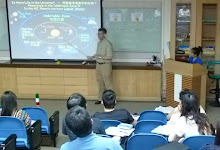Are Falling
Planets “Polluting” Stars With Metals?
After finding evidence
that giant planets fall into stars at higher rates than expected, I
now have found evidence suggesting that the inward migration of giant
planets disrupts smaller planets into the star. At least, that was
the hypothesis I used to guide me to find a correlation between the
planet's orbital eccentricity and the star's iron fraction, expressed
as “Fe/H”. My hypothesis was that perhaps the planets with the
highest eccentricities have more recently begun their migration to
towards the star, and so may have more recently scattered other
planets into the star. The planets that are already “hot Jupiters”,
that is, planets that have already migrated into the short period
orbits that have been largely circularized, have already had more
time pass since disrupting any planets into the star. The star has
had more time to mix the pollution from these planets deeper into the
star, so since I have found that the stars with the highest
eccentricity planets have higher Fe/H, my explanation is this high
Fe/H is in a surface layer having been deposited by recent planet
infall.
I expected that the
pattern would be different for planets in longer orbits that would
not have disrupted planets into the star, and I find that over 200
days, this is the case: the correlation breaks down. It also expect
that low mass planets may not be as effective in disrupting planets
into the star, so I make a cut of 0.1 Jupiter masses. The data for
low mass planets is not as good, so I will either work on more
careful analysis or wait for better data before saying whether this
is the case.
My two recent papers on
this are here:
http://arxiv.org/abs/1211.1984
http://arxiv.org/abs/1301.4229
Could whole-planet
pollution be a significant contributor to measurements of stellar
Fe/H? This is an important question for which I am looking at whether
the numbers of planets is high enough. I am intrigued by a paper by
Zhungmu
Li (astro-ph
1302.0099.)
in which he shows how the tracks of Fe/H in clusters don't follow a
one-population track like you would expect from a single population
in a cluster. Perhaps when stars are young and in clusters, these
stars' metallicities are also affected by the infall of whole
planets.

No comments:
Post a Comment